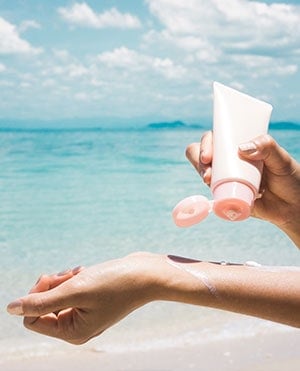

Most consumers choose a sunscreen product based on its sun protection factor, or SPF, often reaching for those with high SPF value, assuming they offer the best protection from the sun’s harmful ultraviolet, or UV, rays. But that is often far from the truth.
SPF values are an unreliable measure of a sunscreen’s effectiveness. A good one should provide equal broad-spectrum protection, protecting against both UVA and UVB rays. But the SPF value reflects only how well a product will protect from UVB rays, the main cause of sunburn and non-melanoma skin cancers, such as squamous cell carcinoma (von Thaler 2010).
Reducing sunburn was the original intent of sun protection products, but it is now known that some UV rays don’t cause sunburn and instead lead to other health harms. SPF values do not reflect a product’s ability to protect from UVA rays, which penetrate the skin more deeply and are associated with skin aging and cancer.
SPF values are also unreliable because the test method companies must use to determine a product’s SPF value is imprecise. It requires someone to determine a change in the skin redness of a small handful of human participants exposed to UV light in a lab. These results may differ based on the evaluator, testing instrumentation or participant skin type. And SPF testing conditions used for labeling significantly overestimate the protection provided in use outdoors.
In the past decade, EWG has tested products and reviewed the results of various studies to verify the sun protection performance of U.S. sunscreen products, however, the available data doesn’t provide confidence that SPF values alone are an accurate measure of protection. Independent testing has revealed a lot about the shortcomings of the FDA’s current requirements for UVA protection from sunscreens.
An EWG peer-reviewed study published in Photodermatology Photoimmunology and Photomedicine found a number of sunscreens sold in the U.S. provide inadequate UVA protection, compared to what the listed SPF would indicate, which gives sunscreen users a false sense of protection. A total of 51 sunscreen products were tested for UV-absorption in a laboratory using in vitro methodologies, and results showed that, on average, products reduced the UVA exposure by only half of what would be expected. Just 18 of 51 products passed the UVA protection test required of products sold in Europe. Given EWG’s findings, consumers should assume many sunscreen products on the market offer lower balanced UVA/UVB protection. We found the UVA protection factor was only a quarter of the labeled SPF, on average.
Most sunscreens tested by EWG also failed to show reliable UVB protection. Our research found that most sunscreens provided just 42 to 59 percent of the UVB protection that might reasonably be expected from the SPF label. U.S. sunscreens had higher labeled SPF values than tests would suggest, in addition to inadequate UVA protection, leaving consumers at potential risk for long-term harm from UV exposure.
Many products tested would not meet the UVA standards set by the European Commission for products sold in Europe. The European Commission recommends sunscreen products’ ratio of UVA protection to SPF be at least one-third. But only about a third of the products tested passed the EU standard, whereas more than nine out of 10 – 94 percent – would get the green light from the Food and Drug Administration.
Test results by the FDA published in 2020 found significant differences in UVA protection among products with the same SPF. Despite the FDA’s awareness of large differences in UVA protection and the connection between UVA exposure and skin cancer, the agency has yet to strengthen the required UVA protection of SPF products. The FDA proposed new rules in 2021 that would require a slightly increased minimum level of UVA protection, but the rules are not yet in place, nor are they strong enough to ensure adequate UVA protection.
Sunscreen products with SPF values above 50+ tend to give users a false sense of security. They not only overpromise protection but may also overexpose consumers to UVA rays and raise their risk of cancer, according to the FDA. Many studies have found that people are more likely to use high SPF products improperly and, as a result, may expose themselves to more harmful ultraviolet radiation than do people who rely on products with lower SPF values.
People trust these high SPF products too much. There are four strikes against SPF values greater than 50+. They include:
Philippe Autier, a scientist formerly at the World Health Organization’s International Agency for Research on Cancer, has conducted many studies of sunbathers and believes that high SPF products spur “profound changes in sun behavior” that may account for the increased melanoma risk found in some studies. In two studies, Autier confirmed that European vacationers spent more total time in the sun if they were given an SPF 30 instead of SPF 10 sunscreen (Autier 1999, 2000). We assume the difference would also apply to products with SPF values greater than 50.
The FDA has long contended that SPF higher than 50 is “inherently misleading” (FDA 2007). SPF values are limited to 50+ in most countires. In 2011, the FDA proposed prohibiting labels higher than SPF 50+. But in its final draft sunscreen rule, published in 2021, the agency proposed raising the cap to 60+. EWG believes the FDA should reconsider this change and instead cap values at 50+.
EWG provides information on sunscreen products from the published scientific literature, to supplement incomplete data available from companies and the government. The ratings indicate both efficacy and the relative level of concern posed by exposure to the ingredients in this product - not the product itself - compared to other sunscreens. The ratings reflect potential health hazards but do not account for the level of exposure or individual susceptibility, factors which determine actual health risks, if any. Methodology | Privacy Policy | Terms & Conditions
